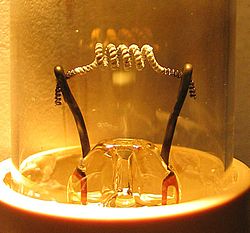
Back Edison-Richardson-Effekt ALS انبعاث أيوني حراري Arabic Termoelektron emissiya Azerbaijani Тэрмаэлектронная эмісія Byelorussian Efecte Edison Catalan Termoemise Czech Edison-Richardson-Effekt German Emisión termoiónica Spanish Termoemissioon Estonian گسیل گرمایونی Persian

Thermionic emission is the liberation of charged particles from a hot electrode whose thermal energy gives some particles enough kinetic energy to escape the material's surface. The particles, sometimes called thermions in early literature, are now known to be ions or electrons. Thermal electron emission specifically refers to emission of electrons and occurs when thermal energy overcomes the material's work function.
After emission, an opposite charge of equal magnitude to the emitted charge is initially left behind in the emitting region. But if the emitter is connected to a battery, that remaining charge is neutralized by charge supplied by the battery as particles are emitted, so the emitter will have the same charge it had before emission. This facilitates additional emission to sustain an electric current. Thomas Edison in 1880 while inventing his light bulb noticed this current, so subsequent scientists referred to the current as the Edison effect, though it wasn't until after the 1897 discovery of the electron that scientists understood that electrons were emitted and why.
Thermionic emission is crucial to the operation of a variety of electronic devices and can be used for electricity generation (such as thermionic converters and electrodynamic tethers) or cooling. Thermionic vacuum tubes emit electrons from a hot cathode into an enclosed vacuum and may steer those emitted electrons with applied voltage. The hot cathode can be a metal filament, a coated metal filament, or a separate structure of metal or carbides or borides of transition metals. Vacuum emission from metals tends to become significant only for temperatures over 1,000 K (730 °C; 1,340 °F). Charge flow increases dramatically with temperature.
The term thermionic emission is now also used to refer to any thermally-excited charge emission process, even when the charge is emitted from one solid-state region into another.
© MMXXIII Rich X Search. We shall prevail. All rights reserved. Rich X Search